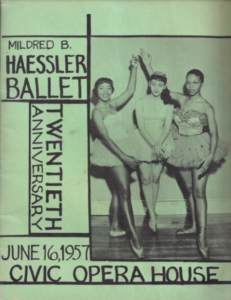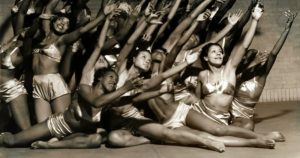1937
American Negro Ballet gives its debut performance
On November 21, 1937, the American Negro Ballet, alternatively called the von Grona Ballet, debuted at the Lafayette Theatre in Harlem. The company’s showcase was conducted by Dean Dixon. The performance’s music was a mixture of ballet staples and modern contemporaries of the time. Igor Stravinsky’s “Firebird” was heard along with choreographic pieces set to the scores of W.C. Handy and Duke Ellington.
“While dancing and directing ballets at Roxy’s Theatre in 1935, [Eugene] explored upper Manhattan, diving into nightclubs. He found their dancers all too light, too sophisticated. ‘I want them black, black, all Negro,’ said von Grona. … Von Grona advertised, offering scholarships, and got hundreds of applications. He picked 20 of the blackest applicants …” ~ TIME Magazine, Nov. 29, 1937
In 1934, German dancer and choreographer Eugene von Grona (1908-2000) formed the American Negro Ballet Company (ANB). As a child from Berlin, von Grona frequently traveled to the United States and was quickly inspired by Black American influence. He was fond of both cakewalk and minstrel shows. Eugene von Grona, along with his wife Leni Bouvier, a dancer as well, made the move to the United States in 1925. The Harlem Renaissance was booming and the German duo were dazzled by the artistic ingenuity of the era.
In 1935, Eugene von Grona, who trained under German dancer and choreographer Mary Wigman, began dancing and choreographing ballets for the Roxy Theatre. In Upper Manhattan, he submerged himself into the nightclub scene, where he looked for Black dancers. “I want them black, black, all Negro,” von Grona is quoted to have said. He scouted them by promoting the company, offering scholarships, and more. Out of hundreds of applicants, Eugene von Grona chose 20 dancers. Two notable dancers in the ANB were Lavinia Williams and Al Bledger. Fellow company members were Teddy Allen, Valerie Black, Marion Brown, Beryl Clarke, Jon Edwards, Anthony Fleming, Viola Gibson, Frank Green, Coleman Hill, Dorothy (Jones) Williams, Harriet Oliver, Evelyn Pilcher, James Smith, Pearl Spears, Hazel Spence, Hetty Stephens, Wahneta Talley, Willard Taylor, and Harry Young.*
A pillar of the American Negro Ballet was that Eugene von Grona wanted to illustrate that Black Americans could be respectable dance artists outside of the jazz dance genre.
On November 21, 1937, the American Negro Ballet, alternatively called the von Grona Ballet, debuted at the Lafayette Theatre in Harlem. The company’s showcase was conducted by Dean Dixon. The performance’s music was a mixture of ballet staples and modern contemporaries of the time. Igor Stravinsky’s “Firebird” was heard along with choreographic pieces set to the scores of W.C. Handy and Duke Ellington. The ANB’s premiere was well received by both critics and audience members. Unfortunately, the American Negro Ballet Company struggled to keep afloat and disbanded in 1938. Eugene von Grona later revamped the ANB, but branded it as “ Von Grona’s American Swing Ballet.” In 1939, the new and improved company was featured in producer Lew Leslie’s Blackbirds as well as other engagements.
*Note that sources have listed alternate spellings for the names of Jon Edwards, Hetty Stephens, and Wahneta Talley.
Sources:
American Negro Ballet Scrapbook, The New York Public Library archives
American Negro Ballet Company, Institute for Advanced Technology in the Humanities at University of Virginia via Social Networks and Archival Context (SNAC)
Eugene von Grona, biographies.net
Time Magazine Nov. 29, 1937 excerpt via blackgirllonghair.com
Mildred B. Haessler founds the Mildred B. Haessler Ballet Company in Chicago, Illinois
Mildred B. Haessler offers to teach ballet classes to predominantly Black children in the Rosenwald Garden Apartments; this evolves into the founding of her school.

In 1937, Mrs. Pearl Pachaco Williams, Recreation Director of the Rosenwald Garden Apartments, started designing a program for the 433 families in the building, which housed predominantly middle class Black families. Mrs. Mildred B. Haessler, resident of Ravinia Park, heard about the curricular planning and offered to teach ballet classes. Haessler, a 10th generation Bostonian, began studying ballet at age 11, attended Vassar College, and went on to receive an A.M. from the University of Illinois. Originally, classes were 35 cents—just enough to pay for the pianists—and offered only for residents of the Rosenwald Building. There were two classes: one for girls seven to ten years old and the other for girls over ten. By 1957, students paid $20 annually for 31 lessons, which drew students from all over Chicago and the suburbs. Eight classes were offered for students ranging in ages from five to 22. Mildred B. Haessler was the director, Pearl Pachaco Williams was the assistant director, and alumni and students acted as teachers and assistant teachers.

The students, as the Mildred B. Haessler Ballet group, gave regular annual performances in Chicago including at the Civic Opera House and the Eight Street Theatre. Prominent Black artist, designer, and activist William McBride Jr. served as art director for the Haessler Ballet Group’s yearly concert. Along with concert programs and pictures of the dancers, the souvenir books McBride composed contained advertisements for, representations of, and endorsements from many sectors of black Chicago society.
While the Ballet Group was not intended to be pre-professional training, some students did go on to have professional dancing careers including Frances Taylor who danced with Katherine Dunham.
Sources:
Other Happenings in 1937
American History
Jan 20: Franklin Delano Roosevelt is sworn in as the President of the United States for the second time.
May 6: The German airship Hindenburg explodes in New Jersey as WLS radio announcer Herbert Morrison states the infamous line, “Oh, the humanity.”
May 27: The Golden Gate Bridge in San Francisco opens.
Jul 2: Amelia Earhart is reported missing on her iconic transatlantic flight.
World History
Dec 12: USS Panay is attacked and sunk by the Japanese during the Sino-Japanese War.
Dec 13: “The Rape of Nanking” occurs when the Chinese capital Nanking falls to Japanese control during the Sino-Japanese War.
May 12: George VI and Lady Elizabeth are crowned king and queen of the United Kingdom.
Arts & Sciences
Feb 6: Of Mice and Men by John Steinbeck is published.
May 28: The automobile company Volkswagen is founded.
Oct 4: Blues singer Bessie Smith dies in an automobile accident near Coahoma, Mississippi.
Dec 21: Walt Disney’s Snow White and the Seven Dwarfs premieres at the Carthay Circle Theater in Los Angeles.
Human & Civil Rights
Jan 11: A riot during a sit-down strike at the Fisher Body Plant No. 2 breaks out when General Motors auto workers are denied food by the police.
Mar 18: The Consolidated School of New London Texas is destroyed by a natural gas explosion.
Sports
Jan 23: Franklin Delano Roosevelt writes letter to the Baseball Writers’ Association commending their craftsmanship.
Jun 3: Josh Gibson of the Negro League’s Homestead Grays hits a ball 580 feet in Yankee Stadium.
Jun 22: Joe Lewis wins the world heavyweight championship in Chicago’s Comiskey Park, becoming the first African American champ since Jack Johnson.



